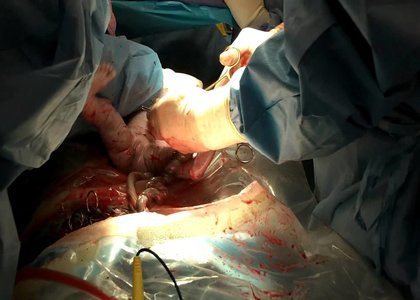- Home
- Editorial
- News
- Practice Guidelines
- Anesthesiology Guidelines
- Cancer Guidelines
- Cardiac Sciences Guidelines
- Critical Care Guidelines
- Dentistry Guidelines
- Dermatology Guidelines
- Diabetes and Endo Guidelines
- Diagnostics Guidelines
- ENT Guidelines
- Featured Practice Guidelines
- Gastroenterology Guidelines
- Geriatrics Guidelines
- Medicine Guidelines
- Nephrology Guidelines
- Neurosciences Guidelines
- Obs and Gynae Guidelines
- Ophthalmology Guidelines
- Orthopaedics Guidelines
- Paediatrics Guidelines
- Psychiatry Guidelines
- Pulmonology Guidelines
- Radiology Guidelines
- Surgery Guidelines
- Urology Guidelines
C Section deliveries in India- Too many for rich,very few for poor

Only 2.2% of C-section deliveries are happening in rural parts of India while the proposed standard by the WHO is 10-15%. However, the situation is other way around in the richer quantile. There were certain findings highlghted by the data derived from the National Family and Health Survey conducted in 2015-16
The C-section rate in India has increased expeditiously. As per the data which came out of the National Family and Health Survey the rate is above the standards proposed by the World Health Organization and even above than what is observed in the developed countries. But most importantly, the main concern is are these procedures were carried under appropriate indications?
Cesarean section (CS) when indicated is a life-saving procedure but when performed without appropriate indications can add risk to both mother and baby. As per the recently published WHO report, at the population level, Cesarean section rates higher than 10% are not associated with reductions in maternal and newborn mortality rate.
The data derived from the latest National Family and Health Survey conducted in 2015-2016 shed a lot of light on childbirth practices across the country. A study(1) by IRD researchers has recently examined existing evidence and been able to chart some of the main trends and differentials.
"The first finding of this study relates to the rapid increase in the number of cesarean deliveries performed in India since the last survey conducted in 2005-2006, a transformation linked to the increasing proportion of women delivering in hospitals," declares Christophe Z. Guilmoto, demographer at Ceped research unit. 17.2 % of births in India were estimated to have been delivered by cesarean in 2010-16. This cesarean rate is already above the benchmark of 10-15 % proposed by WHO and above levels observed in richer countries such as the Netherlands or Finland.
A second finding is that this national average of 17,2 % conceals considerable variations across social categories and regions. Many regions still lack access to adequate maternal facilities and cesarean rates in states such as Bihar or Madhya Pradesh lie below the 10% level advanced by WHO. But the situation appears even more critical among the poorest quintile of the population (4.4% of births delivered by cesarean), leading to extreme inequality in the access to cesarean within the country. "During the same period, more than a third of the births are delivered by cesarean section among the richest quintile and in several states of South India such Andhra Pradesh, Kerala and Telangana -with rates above 50% reported in some districts," underlines Alexandre Dumont, an epidemiologist in the same unit. Such elevated rates point to the frequent use of surgical deliveries among low-risk pregnancies, especially in private facilities-this in spite of potential complications such as infection or hemorrhage.
All in all, the study estimated that the shortfall of cesarean deliveries in the poorest regions represented 2.2% of deliveries in 2010-16, while the excess observed in more prosperous populations accounted for 7.0% of them. This analysis highlights the double burden facing today India's health authorities: on the one hand, the need to improve access to secure deliveries in many districts of North India and among the poor in order to reduce maternal and neonatal mortality, and on the other hand, the challenges presented by the growing overuse of cesarean deliveries in more advanced parts of the country. For the researchers, current trends and India's economic progress suggest that the proportion of births delivered by C-section will continue to increase in the future well above medically-justifiable levels unless efforts are made to curb the over-medicalization of childbirth.

Disclaimer: This site is primarily intended for healthcare professionals. Any content/information on this website does not replace the advice of medical and/or health professionals and should not be construed as medical/diagnostic advice/endorsement or prescription. Use of this site is subject to our terms of use, privacy policy, advertisement policy. © 2020 Minerva Medical Treatment Pvt Ltd